I consider myself a dynamic professional in that I am always looking for ways to improve in my profession. There will never be a time where I feel that I have “arrived” and learned everything I can about my content or my teaching of the content. I am continually learning be that based on my daily interactions with students to discern their understanding or my perusing through listservs and Facebook Educator groups. In the following pages you will read my commitment to professional growth and how apply my learnings to how I design experiences in the classroom.
Curriculum | Discipline Design
This is what I love most about my job. If I could do this all day long, I would. I absolutely love reviewing concepts and laying out a plan for optimizing students engagement and learning. Even with planned lessons, I am always tweaking and fine tuning to make things better. The optimum goal is that students learn concepts in my class related to the subject that I am teaching but I also build in areas for them to connect to the world beyond the classroom to give their learning greater context. In addition, I pay equal attention to designing curricula that some may call a hidden agenda. Although I am not always explicit with students on what that agenda is, I don’t do it to hide anything from them. If they ask why I do things that way that I do, I always have a reason. I am very upfront with students from the beginning of the year that there is a “method to my madness.” Most of my work is grounded in very Piagetian foundations of learning but also based on the idea that students develop their ways of understanding through repeated reasoning. Part of that is concepts in the subject and another part is their development of themselves as learners and problem solvers.
(1) designs and implements courses that reflect teacher mastery of their academic discipline and its teaching methodologies
The concept of stoichiometry tends to be difficult for beginning chemistry students. There are a lot of moving parts to successfully solving a stoichiometry problem. As I have grown in my teaching of chemistry, I noticed that a major conceptual problem was the issue of limiting reactant (the compound that limits how much you can make of the products). The traditional way of teaching stoichiometry is to avoid the issue of limiting reactant for as long as possible building up the students’ abilities to do problems that are simpler where limiting reactants isn’t a factor. What I found when I did that was that students then saw the idea of limiting reactant to be very complex, making it more difficult in their minds than it really is.
A few years ago, I decided to experiment by introducing a technique that is usually saved for and Advanced Chemistry course in the high school level or even second semester chemistry at the college level. This involved teaching the kids to use something called an ICE chart. Where “I” stands for “initial,” “C” stands for “change’” and “E” stands for “end.” Every number that is put into an ICE chart is in moles and the ratio in the change row has to match the ratio in the balanced chemical equation. The lesson for ICE charts uses students experience with, for example, making a sandwich as an entry point. 10/27 (Day 16) Intro to Stoichiometry I don’t avoid the idea of limiting reagent because intuitively students understand the idea of not having enough of something. So we work through an example with sandwiches and move to bikes below and then immediately move to the chemical reaction between magnesium and nitrogen gas. The number start simple but as we move through the lesson, the students end up capable to relatively easily master the ICE charts on the homework where there are only chemical reactions. KEY-HW: Mole Relationships
One added benefit for teaching stoichiometry this way is that I no longer have to spend time in advanced chemistry teaching students how to use ICE charts. The are very familiar with them making the difficult concept of acid-base equilibria and little less daunting.
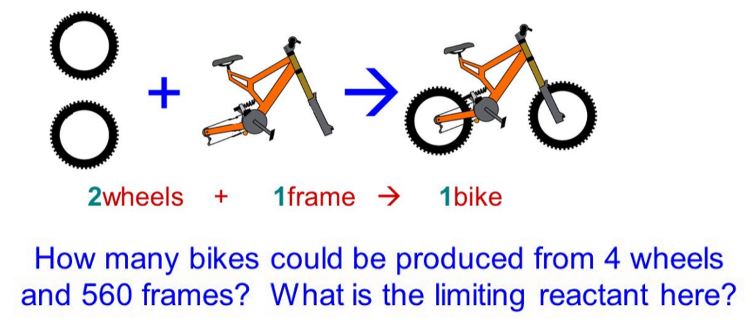

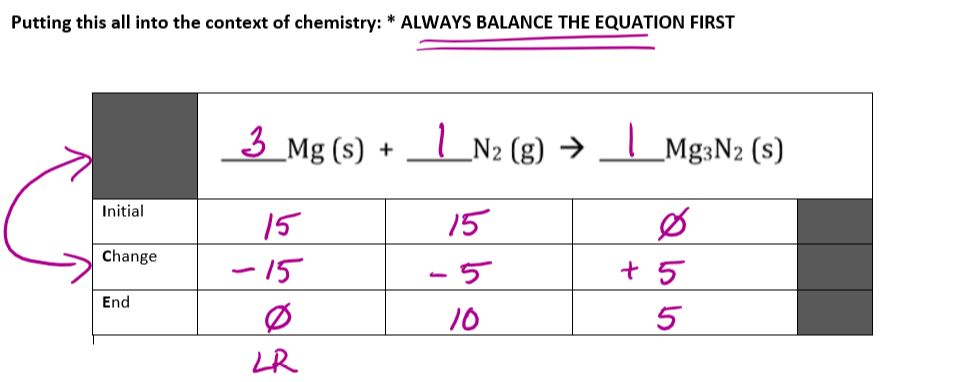
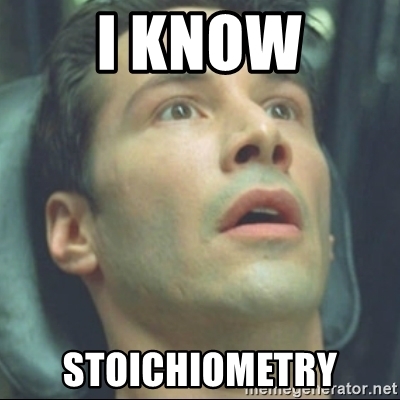
(2) designs and implements courses framed by the school’s pedagogical tenets – inquiry, experience, and integration
The way that I use laboratory activties is mainly to reinforce the learning of content by providing hands on opportunities for students to engage in the content in the ways that a chemist would. This takes the textbook problem solving into more real world scenarios. For example, after completing content where 10th grade students learned about chemical reactions and the mathematics behind chemical reactions, stoichiometry, they were asked to analyze water samples for hardness levels. The Hard Water Lab is an example of this was already mentioned in the “Differentiated Instruction” section of the “Pedagogical Practice” domain: (4) provides alternative explanations of course concepts
As the students progress in their knowledge and development of their scientific thinking, the lab activties have less detail and require more insight and development on behalf of the students. In the Fall Trimester of Advanced Chemistry, students engaged in a lab activity to help refine their understanding of chemical kinetics Kinetics Lab Investigation: Bleach & Food Dye. For this activity, they were given less information that provided in the Hard Water Lab but also more time to experiment with their techniques and revise their procedures in order to obtain viable results for determining the rate law for the reaction between bleach and a food dye of their choice. An example of the trial and error and resolution can be seen in this group’s work Student Work for Kinetics Lab Investigation: Bleach & Food Dye-Neta & Rayhan. Each group presented their work at the end often including images of their work.
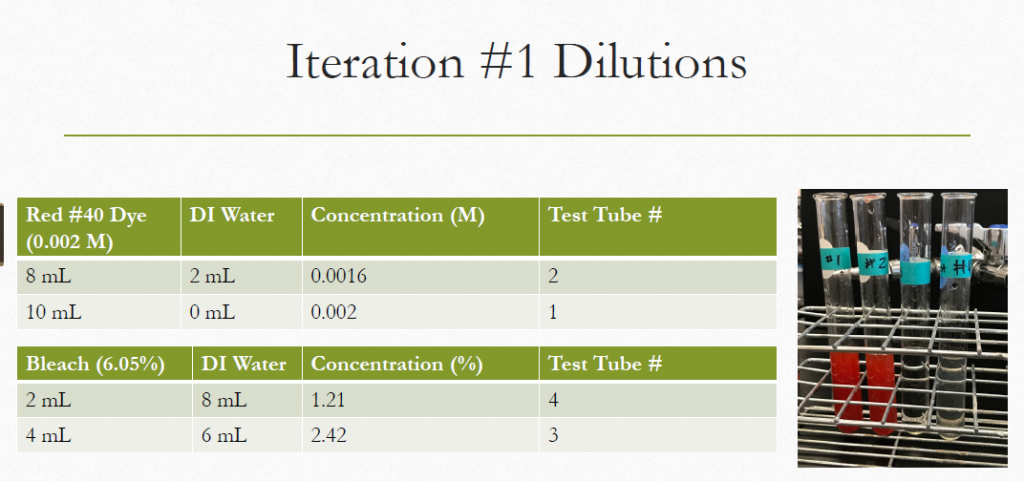
I find that students don’t always directly tie their textbook learnings to their lab investigations. In both scenarios above, students needed to be reminded that they had the necessary background in their chemical content knowledge to design the procedure and analyze the results. As a result of performing the lab investigation, students often strengthen their content knowledge and understand how to apply that knowledge in a more real world scenario.
(3) collaboratively designs and evolves course curricula that are reflective of their academic discipline’s philosophy and derivative of the school’s overarching philosophy
EPS is a very collaborative environment which makes team teaching a course allowing for both professional growth as well as personally satisfying. Working with one or more instructors for a course allows me to see things in a different light as well as find support with classroom culture or the needs of individual students. For each course that I have worked with other teachers to develop a course, I have learned a lot about myself as a teacher as well as a colleague. The collaborative development of these courses has allowed for new insights and fresh looks at topics that I am very familiar with teaching as well as topics that are very new to my teaching repertoire.
However, no better satisfaction has been gained than in the 6th/10th grade Communicating Science project where 10th graders teach 6th graders about chemical reactions. 6th/10th Grade Teaching Project-Communicating Science This is project that started prior to my start at EPS but has continued even through our online year during COVID-19. The first year I participated was also Krissy Russell’s, 6th grade science teacher, first year at EPS.

All of us liked the experience so much that we expanded it our second year to have a reciprocal interaction where 6th graders showed a draft of their materials science presentations for feedback from 10th graders. We made some modifications during COVID to include Flipgrid videos to share with 6th graders. https://flipgrid.com/28119d52
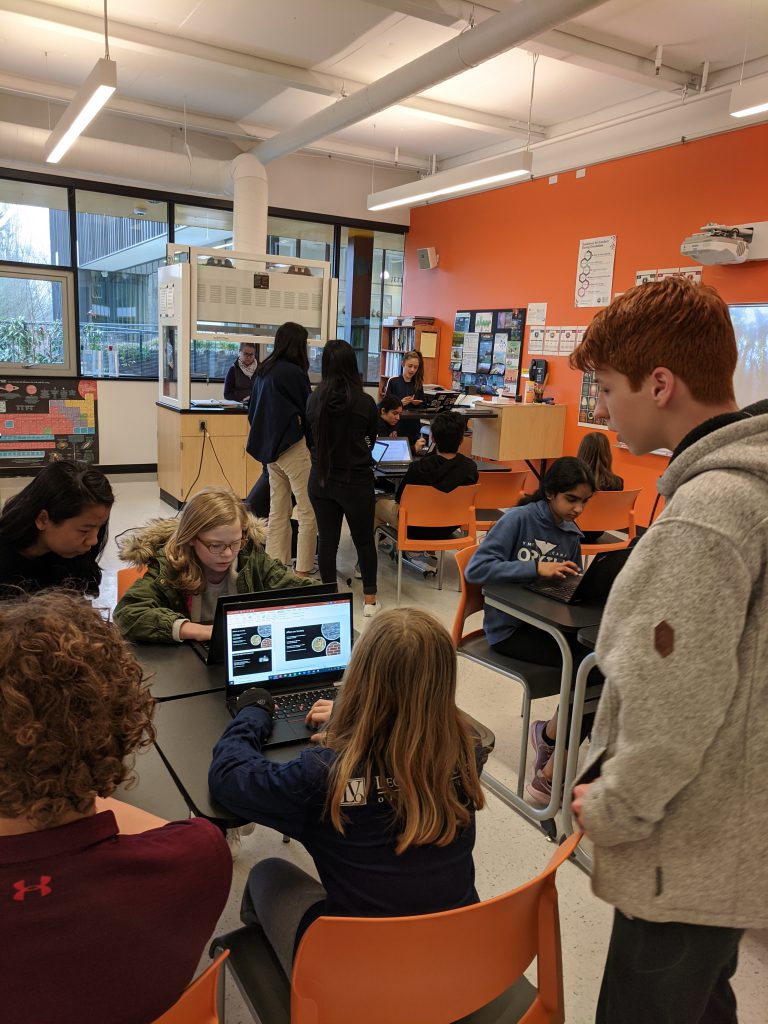
(4) updates course content to reflect the contemporary world
I am always working to make the content that I teach in the classroom relevant to the broader world in terms of the applications outside the classroom. Most of these connections are related to lab activities which you can read about in the section above on (2) designs and implements courses framed by the school’s pedagogical tenets – inquiry, experience, and integration Yet, sometimes the real world overlaps with the classroom content in the most serendipitous way.

When Kip Wassink and I were introducing DNA in our unit in 9th grade biology course in the Fall Trimester of 2020, it was as if we planned or knew ahead of time that CRISPR would win the Nobel prize in chemistry. CRISPR-2020 Nobel Prize in Chemistry This is perhaps the most serendipitous opportunity to bring in the contemporary world as a direct tie to what the kids are learning in class. Our lesson plan (see image to the right) the day before the article in Nature was published focused on some basic chemistry in order to introduce DNA as our bodies genetic code. It gave us an opportunity to make a connection with what the kids were learning about DNA to the news of the day.
In addition, it had the added bonus of this Nobel prize being awarded to two women both of whom told stories in the coming weeks about their hurdles of being a woman in STEM. As we continued our understanding of genetics and DNA replication, I was able to refer back to CRISPR multiple times as well as share the stories of these women as I read about them over the course of a few weeks.
There are some lessons that we plan purposefully to connect to the real world as a result of topics of interest in the contemporary world but then there are lessons that take on new forms as a result of the contemporary world overlapping with pre-planned lessons. In my opinion, the former enhances learning but the latter excites it.
Program | Professional Development
As we strive in our educational jobs to create life-long learners out of our students, I think it is important to model that in our own professional and personal lives. The evidence and explanations in the indicators for this category support the professional side of continued learning for me. On the personal side, I continue to learn where upcoming opportunities include a continuing education course on memoire writing at UW in the fall of 2022. This summer, I am hoping to learn how to either windsurf or kiteboard depending on weather and availability in the Hood river area. I am always eager to learn and do new things.
(1) participates actively and constructively in Program Development Day activities
I have participated actively in PDD days throughout my time at EPS. As the years have moved on, I have voluntarily taken a more active role in terms of sharing as you will see in my Evo of Instruction presentations which you will read more about in the next section: (2) presents during Program Development Days and conferences
The way that I approach these days is in terms of Professional Development. In other words, what can I learn to make what I do in the classroom better? Although that would say my focus is on my classroom part of that development also requires building connections and relationship with colleagues so that conversations continue outside of PDD days.
There have been multiple times that I have been selected to lead a discussion especially during the year online Group Leader-11-30-2020 PDD where facilitators would use break out groups in Teams to allow for more active engagement. This year, in person, I was selected to facilitate our first “Home Group” which resulted in us gathering in the chemistry classroom in TMAC and establishing norms for our group.

What I have enjoyed most about our home group is that after our initial meeting, there was no need for us to have a facilitator and conversation flowed smoothly with lots of laughter but all in a safe space that allowed us to be vulnerable. This helped create camaraderie with members of our community that we all don’t normally interact with on a regular basis. In essence, this does not directly impact my classroom but the impact is indirect. We are all here to serve the same student body population. Knowing that I have such caring, smart and thoughtful colleagues helps my professional development in that I feel confident that we are all on the same page in terms of our care and shaping of our students. The added bonus is that I also have relationships with peers that I know that I can come to if I ever need feedback or input in any situation.
(2) presents during Program Development Days and conferences
This year, I had the opportunity to share with the EPS community during our Evo of Instruction presentations on our PDD days. I ended up sharing in two given that I had more to share than would fit in one presentation making me the first person to do a part 1 and part 2 for my presentations.

The theme for our December 2021 Evo of Instruction was “Designed Classroom Experiences” where I wanted to share the development of the Lab Contract for the Advanced Chemistry course. I say more about that in the “Differentiated Instruction” section of the “Pedagogical Practice” domain: (2) designs class activities and assignments that engage and accommodate for both individual students and a diverse group of learners In this presentation, I focused on designing the experience for the kids including the purpose, the planning and the pitfalls.
For part two, I wanted to share more about the process and the actual execution of the Lab Contract given the Evo of Instruction theme for January 2022 of “Innovative Instruction.” Given the fact that kids were working on different labs during each class period, there was no whole class direct instruction. The instruction came in the form of conversations with students or groups of students as they worked through the lab activities. This also came in the form of the feedback loop that I created for the three mandatory labs (which technically means that I could have done a part 3 since the next Evo of Instruction’s theme was feedback). I discuss this in the link above.
In graduate school, I was a regular presenter at conferences so having the opportunity to share work directly with the community that I am part of was highly satisfying. As a result of these presentations, I had many wonderful conversations with peers teaching at all grade levels including some asking for my “Lab Contract” to use as a template for their own planning.
(3) builds in opportunities for each student to contribute during each class period
This is something that I make more explicitly part of the course in more introductory courses with 9th and 10th graders. In the early years of high school, I find that students need more encouragement to share their answers. In the advanced chemistry course, I have the similar opportunities but I am less intentional when it comes to having students share in front of their peers. In every class, I build in work time whether lab or practice where students all contribute their input in their table groups or with neighboring students. Below are examples of an intentional opportunity for chemistry students to share a solution to the warm-up. Here there is enough for each student to do one and for some students to do two.

(3) takes advantage of professional development provided by the school
Most of this is related to our PDD day which I have already discussed in the above sections: (1) participates actively and constructively in Program Development Day activities and (2) presents during Program Development Days and conferences .
But mainly, or currently, this year, I am participating the in Profession Development Program (PDP) as one of five candidates in the 2021-2022 school year being the second cohort that will be completing the program. Although the additional work has sometimes been a challenge to fit into my schedule, the best thing about this program is the conversation that happens during the PDP committee meetings. The structure of praise, feedback and questions allows me to acknowledge the good that I am doing in the classroom while also needing to be explicit about what I do and why I do it. The questions allow me to think more deeply about my teaching as a professional in ways that I haven’t done in many years.

(4) identifies and pursues professional development opportunities appropriate to enhancing effectiveness as an educator
I am always on the path for developing my professional practice. I have been part of the ChemEd listserv for many years where professors and teachers post questions about teaching and questions about content. These have been interesting to read over the years in terms of what we choose to teach in an introductory chemistry class and how we sometimes butcher our simplifications that make it then difficult for budding chemists to reconcile their knowledge in more advanced courses.
As we went online for COVID, a couple of Facebook groups popped up. One of my favorites that is still very active is called “Strategies for Teaching Chemistry.” The content in this group at the beginning focused on how to teach chemistry online. Since going back in person, it has morphed to sharing ideas for teaching content or asking about best practices. In addition, it has become a place where folks have shared job opportunities and professional development opportunities including asking for submissions to present at conferences. I never thought that I would say this but this is my “go-to” when I am interested in current practices in chemistry education.

With the support of EPS, I have had the opportunity my first year to participate in a full day workshop with Edward Tufte “Presenting Data and Information.” I have been a fan of Tufte for many years as someone who questions how we present data in order to share information that the data holds in the most efficient but also aesthetically pleasing way. The goal for myself long term for this workshop is to expand options for presenting data. One direct result of this was giving students the opportunity to present their lab results in the “Lab Contract” using a couple of alternative formats. One was a mini-poster presentations which I will admit is not very innovative since scientists do poster presentations often. The other was what I called a “Lab Comic.” This gives students the opportunity to share their results in a visual and entertaining way.
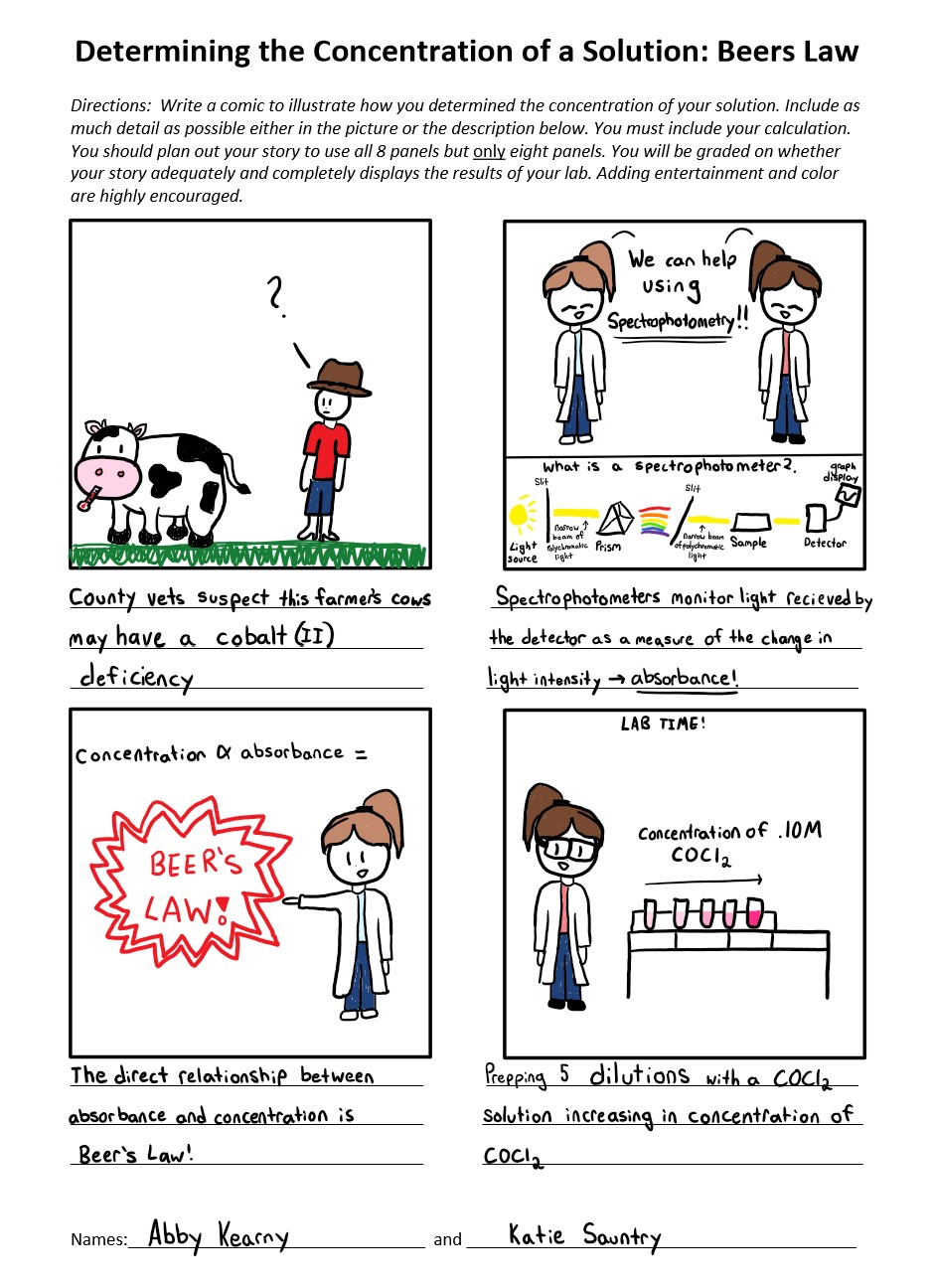
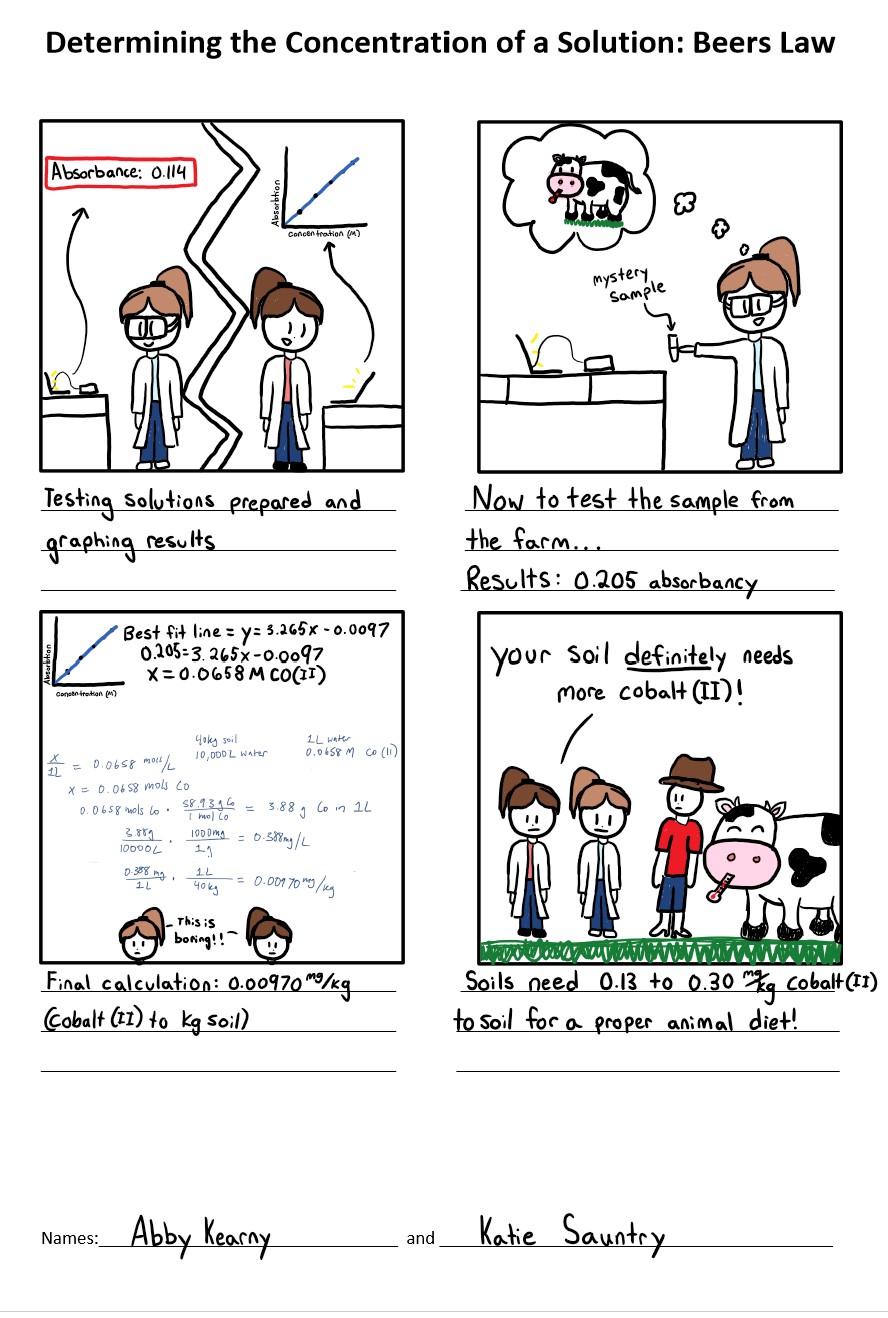
During the fall of 2020-2021 school (one where we were mostly remote), I attended an online workshop run by the National Science Teachers Association on distance learning. For me, since we had spent the remainder of winter trimester and all of spring in 2020 online, this workshop was more about sharing learnings, successes and suggestions to a group of high school teachers in break-out sessions than I, myself, personally learned. That being said, it was a rewarding experience to support a community of science teachers all wondering similar things about teaching science remotely especially how to replicate the lab experience.